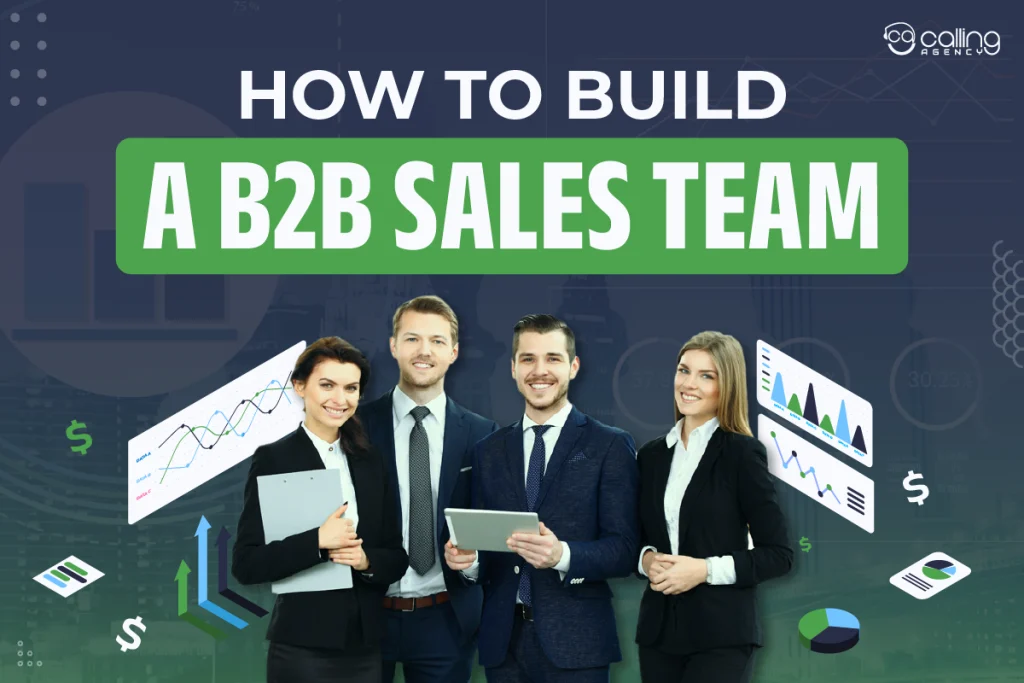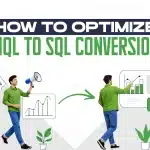Building a high-performing B2B sales team requires more than just hiring talented salespeople. It needs a strategic approach that aligns structure, processes, and people with your business goals. The foundational decisions you make around team composition, hiring criteria, compensation models, and sales processes will determine whether your team becomes a consistent revenue driver or struggles to meet targets.
This guide will show you the essential steps to build a B2B sales team that will successfully generate leads for you, build strong customer relationships, and increase your revenue.
What is a B2B Sales Team?
A B2B sales team is the team that sells products and services from one business to another, a model known as business-to-business (B2B) sales. Unlike business-to-consumer (B2C) sales, B2B sales often involve larger order values, more complex sales cycles, and multiple decision-makers within the buying business.
A B2B sales team focuses on building relationships and demonstrating the return on investment (ROI) a product or service will bring to another company. According to a study by the Bridge Group, companies with sales specialization experience 15% faster revenue growth compared to those with generalist roles.
How to Define Strategy Before Hiring a B2B Sales Team
Your sales team plays the main role in generating qualified B2B leads, which is why you need a strategic plan to hire the right team. To define a strategy before hiring a B2B sales team, you must understand your target market, craft a compelling value proposition, and align sales and marketing efforts.
Choose the right sales channels and methodology, define clear sales goals and KPIs, and plan for sales team structure and compensation. Establish training and ongoing support to ensure the team has the skills and tools to succeed.
Here’s how you can define strategy before hiring a B2B sales team:
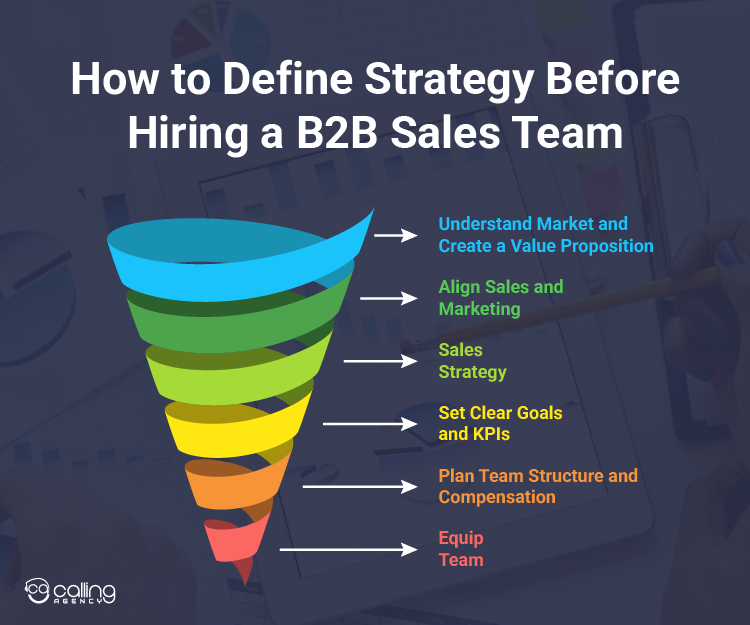
Understand Your Market and Create a Value Proposition
Research and identify your Ideal Customer Profile (ICP) by analyzing existing customers, industry data, and market research. Understand their needs, pain points, and decision-making processes. Then clearly state how your product or service solves your target customers’ problems uniquely, improves efficiency, or offers a strong return on investment. This is your unique selling point.
Align Sales and Marketing
Make sure that your marketing team works closely with the sales team to attract, qualify, and nurture leads. Create valuable content that speaks to your target audience’s needs and pain points. The marketing and sales teams should work with the vision of attaining the same goals and share strategies to achieve them.
Sales Strategy
Choose a sales methodology first. Decide if your approach will be inbound, outbound, or a hybrid model. Consider Account-Based Marketing (ABM) for highly targeted campaigns. Analyze and choose the channels where your target market is most likely to engage, such as direct sales, online platforms, distributors, or resellers.
Set Clear Goals and KPIs
Set specific, measurable, achievable, relevant, and time-bound (SMART) sales goals. This includes revenue targets, market penetration, and customer acquisition cost (CAC) goals. Define the metrics you will need to use for tracking progress and measuring the success of your sales strategy.
Plan Your Team Structure and Compensation
Determine a specific sales team structure by designing a structure that aligns with your business goals, products, and target market. Set realistic targets and provide proper incentives to motivate your sales team to achieve goals.
Equip Your Team
Provide proper training to equip your team with the skills and knowledge needed to succeed. Implement CRM (Customer Relationship Management) technologies and other sales enablement tools to speed up the processes. Also, encourage knowledge sharing and provide ongoing support and feedback to help the team overcome challenges and improve performance.
How Do You Structure a B2B Sales Team?
To structure a B2B sales team step-by-step, define your goals, choose a team structure, develop a sales process, recruit talent, use technology, create a high-performing culture, track, and optimize performance to build an effective B2B sales team.
Here is a step-by-step guide on how you can build an effective B2B sales team:
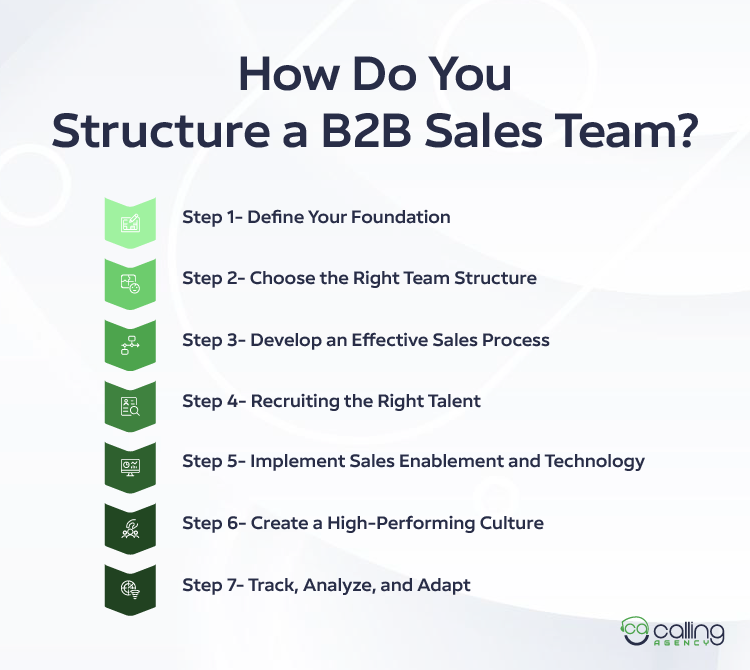
Step 1: Define Your Foundation
The first step requires you to define your foundation, which involves setting clear goals, understanding your buyers, and outlining your sales strategy and process.
- Establish specific, measurable, achievable, relevant, and time-bound (SMART) sales goals, such as revenue targets or market penetration, to provide direction.
- Develop detailed buyer personas to understand your ideal customer’s needs, challenges, and decision-making processes.
- Map out the detailed stages of your B2B sales process, from lead generation to follow-up and retention, ensuring consistency.
Step 2: Choose the Right Team Structure
After building your foundation, you will have to select a sales team structure that will align with your business goals and target audience.
- Divide the team by function for prospecting, closing, and expansion to build expertise in different fields.
- Assign your sales reps according to specific customer types.
- Divide the market geographically and make sure that roles clearly align with specific parts of the sales process.
Step 3: Develop an Effective Sales Process
Create a detailed sales process by mapping the customer journeys and documenting your processes on each stage of the funnel.
- Map the buyer journey by outlining the steps your prospects take from initial contact to closing the deal.
- Create clear, documented workflows for each stage to ensure consistency and efficiency.
- Make sure that the sales team sticks to the regulations and works together efficiently, aligning with the business goals.
Step 4: Recruiting the Right Talent
To make your sales processes successful, make sure you are hiring the right people, assigning them to suitable positions, and developing a comprehensive onboarding program.
- Thoroughly analyze and recruit professionals with the specialized skills needed for each role you have defined.
- Make sure you are assigning them the jobs they are the most expert at so that there are no clashes within the organization.
- Create a comprehensive onboarding process to quickly integrate new hires and ensure they understand the product, process, and culture.
Step 5: Implement Sales Enablement and Technology
You cannot compete in the market without the use of technology today. So, use specialized tools and integrate them with marketing for successful lead generation.
- Invest in CRM software, sales enablement platforms, and other technologies to speed up operations and provide reps with the necessary resources.
- Provide your reps with technology and knowledge about them to make sure they can handle the customers effectively.
- Ensure smooth integration and alignment between marketing and sales efforts to support lead generation and nurturing.
Step 6: Create a High-Performing Culture
Your sales team needs to be high-performing in order to attain the organizational goals through collaboration and continuous learning.
- Create a supportive environment where team members can share knowledge and work together effectively.
- Make sure the sales team and the marketing team have the same shared goals, shared strategies, and shared marketing tools.
- Continuously promote ongoing training, upskilling, and adaptation to new market trends and product features.
Step 7: Track, Analyze, and Adapt
Track and analyze your sales team’s performance by monitoring key metrics, and adapt to new approaches by providing ongoing coaching.
- Track essential sales metrics to assess your sales team’s performance and identify areas for improvement.
- Offer continuous coaching and feedback to help team members develop their skills and reach their potential.
- Be flexible and prepared to adapt your strategy and structure as your business grows and the market evolves.
Define Roles, Responsibilities, and Ratios in the Sales Team
In a B2B sales team, roles define specialized functions, responsibilities are the specific tasks within each role, and ratios are the proportional relationships between different roles or team members to optimize efficiency and revenue generation. This structured approach makes sure specialized skills are utilized, creating a smooth sales process from lead generation to customer loyalty and maximizing overall team performance.
Roles and Responsibilities
A B2B sales team structure usually includes several key roles, each with different types of responsibilities. The roles, along with their responsibilities, are described below:
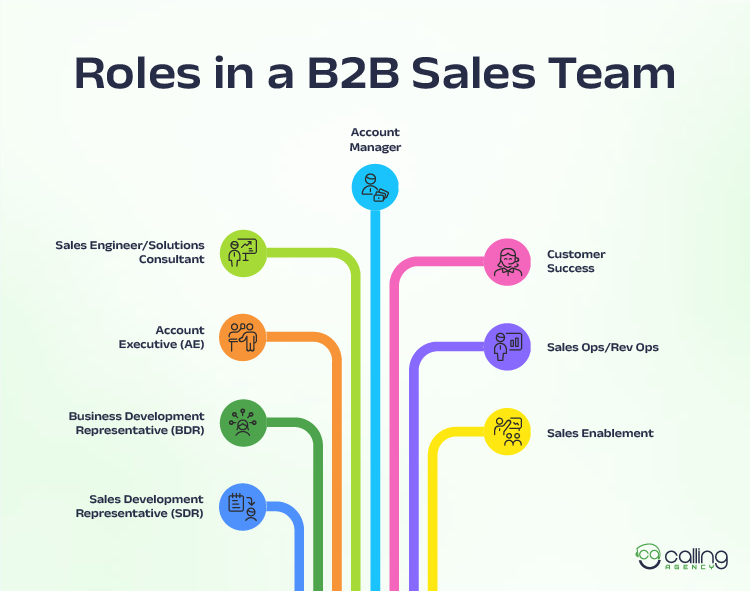
Sales Development Representative (SDR)
An SDR is a specialist who is at the top of the funnel of the sales process, identifying and qualifying potential leads for the sales team to close. Their primary responsibility is to create a healthy sales pipeline by conducting research, reaching out to prospects through multiple channels, and nurturing them until they are ready for a more experienced sales rep to take over and finalize the deal.
Teams with dedicated Sales Development Reps (SDRs) generate a remarkable 400% more qualified leads than teams where Account Executives manage their own prospecting.
Business Development Representative (BDR)
A BDR is also an entry-level sales position focused on outbound prospecting and generating new leads for Account Executives (AEs) for them to manage the sales cycle more efficiently and easily.
BDRs find potential customers using tools like cold calling, email outreach, and social selling, then qualify them and schedule introductory calls or meetings for the AEs to fill the sales pipeline and drive predictable revenue growth for the company.
Account Executive (AE)
An account executive is a sales professional who manages the entire sales cycle to acquire new business clients and grow relationships with existing ones, focusing on revenue generation, client satisfaction, and long-term partnerships.
Their key responsibilities include prospecting, building client relationships, conducting sales presentations, negotiating contracts, and collaborating with internal teams like marketing and customer success. AEs should close 25-35% of all the opportunities they receive.
Sales Engineer/Solutions Consultant
A sales engineer or solutions consultant is a technical expert and trusted advisor who demonstrates complex products, translates technical features into business value, and customizes solutions for potential clients.
They mix deep technical knowledge with business and strong communication skills, playing a crucial role in the technical validation stage of the B2B sales process to build trust, ensure customer needs are met, and close deals.
Account Manager
An account manager manages relationships with existing clients to create loyalty, drive revenue growth, and ensure client satisfaction, acting as the primary point of contact and a strategic advisor to help clients achieve their goals with the company’s products or services.
Their key responsibilities include understanding evolving client needs, identifying upsell and cross-sell opportunities, providing high-level support, and collaborating with internal teams.
Customer Success
Customer success ensures clients achieve their desired business outcomes using your product or service through long-term relationship building, proactive support, and strategic guidance from the initial sale through implementation and ongoing use.
This approach minimizes churn, increases loyalty, and drives recurring revenue by making sure that customers get maximum value from their investment and become advocates for your brand in the future.
Sales Ops/Rev Ops
In B2B sales, Sales Operations (Sales Ops) and Revenue Operations (RevOps) both focus on improving efficiency and boosting revenue, but they differ significantly in scope.
Sales Ops focuses specifically on the sales team’s activities, forecasting, and enablement. On the other hand, RevOps provides a broader strategy that aligns marketing, sales, technology, and customer success.
Sales Enablement
The role of sales enablement is to strategically equip and develop the sales team with the right content, technology, training, and processes to improve sales effectiveness, efficiency, and predictability.
Sales enablement effectively aligns marketing and sales to deliver a consistent, personalized buyer experience, leading to higher win rates, faster rep onboarding, and increased revenue. Forrester found that 66% of high-performing sales enablement leaders recommend that sales enablement should deploy new sales technology.
Ratios
Ratios are used in B2B sales teams to measure performance, identify bottlenecks in the sales process, evaluate the effectiveness of strategies, improve lead quality, and inform strategic decision-making to drive revenue and profitability. The key ratios in a B2B sales team are described below:
- Closing Ratio: This measures the percentage of sales opportunities that successfully result in a closed deal. A strong win rate (often above 25%) indicates effective sales strategies and a deep understanding of customer needs.
- Lead-to-Opportunity Ratio: This ratio shows what percentage of qualified leads turn into sales opportunities. A strong ratio (50-80%) demonstrates accurate lead qualification, while a low ratio might signal ineffective follow-up or over-qualifying.
- Pipeline-to-Quota Ratio: This ratio is also known as sales pipeline coverage. It compares the total value of your sales pipeline to your sales quota. A healthy ratio is typically 3-4 times your quota to ensure consistent quota attainment.
- Demo-to-Close Ratio: This ratio is specifically for SaaS and other businesses offering demos. It indicates how many demos result in a closed deal. An industry average is often around 15-20%, showing the effectiveness of the product demonstration.
- CLV to CAC Ratio: Customer lifetime value (CLV) to customer acquisition cost (CAC) ratio shows the value a customer brings versus the cost of acquiring them. An ideal ratio is 3:1 or higher, meaning the generated customer value is three times the acquisition cost.
Hiring Profile, Interviews, and Onboarding for Your B2B Sales Team
To hire effectively for a B2B sales team, define the right hiring profile by identifying key skills like communication, problem-solving, and B2B sales experience. Then, use structured interviews with role-playing and scenario-based questions to assess these skills and cultural fit. Finally, implement a comprehensive onboarding focused on product knowledge, sales processes, and tools to set new hires up for success.
Hiring Profile
A strong B2B sales team hiring profile emphasizes qualities like a results-oriented mindset, strong communication and relationship-building skills, strategic thinking, and technical skills with CRM and sales engagement tools.
Key characteristics to look for include persistence, curiosity, empathy, and a commitment to continuous learning, especially in navigating complex, long-term sales cycles. A good profile balances experience with foundational traits, such as the “hungry, humble, honest, coachable, curious, and competent” qualities, to ensure both immediate and long-term success.
Interviews
B2B sales interviews assess a candidate’s skills in lead generation, pipeline management, client relationship building, objection handling, and strategic thinking through questions about their experience, problem-solving abilities, and knowledge of sales methodologies, and their ability to articulate a clear value proposition.
To prepare, candidates should thoroughly research the company and role, prepare quantifiable achievements, and be ready to demonstrate their ability to adapt their approach to different client needs and market trends.
Onboarding
B2B sales team onboarding is a comprehensive, structured process that integrates new sales representatives into a company by teaching them product knowledge, sales processes, company culture, and the use of relevant tools, transforming them into productive, revenue-generating assets.
Key elements include defining goals and metrics, a structured approach like a 30-60-90-day plan, hybrid learning, ongoing coaching, and practical application, all focused on achieving long-term productivity, skill development, and improved sales talent retention. The good news is that offering quality training and onboarding during this period means your sales team will improve their ability to hit quota by 16.2%.
Conclusion
Building a successful B2B sales team requires patience, strategic thinking, and continuous optimization. While the initial setup is important, the best sales organizations are those that adapt and evolve based on market feedback and performance data.
Start with a solid foundation of clear processes, the right people, and aligned incentives, then be prepared to refine your approach as you scale. With these fundamentals in place, you’ll be well-positioned to build a sales team that drives sustainable growth and becomes a competitive advantage for your business.
Need more professional guidelines for growing your B2B business? Stay connected to us and never miss an update!
FAQ
What Roles Are Needed in a B2B Sales Team?
The roles needed in a B2B sales team are Sales Development Representative (SDR), Business Development Representative (BDR), Account Executive (AE), Sales Engineer/Solutions Consultant, Account Manager, Customer Success, Sales Ops/Rev Ops, and Sales Enablement.
How Do I Decide Between Inbound and Outbound SDR?
To decide between an inbound and outbound Sales Development Representative (SDR) role, consider your business’s target market, sales cycle complexity, and lead generation strategy.
How Do SDRs Differ from AEs?
SDRs are at the top of the funnel, skilled in outbound prospecting and handling rejection. AEs handle the middle and bottom of the funnel and excel in product demonstrations, persuasion, and client management.
What Should a Sales Playbook Include?
A comprehensive sales playbook should include a Company & Product Overview, Buyer Personas, a Sales Process, a Sales Methodology and messaging, Sales Plays and scripts for specific scenarios, and guidelines for Objection Handling.

